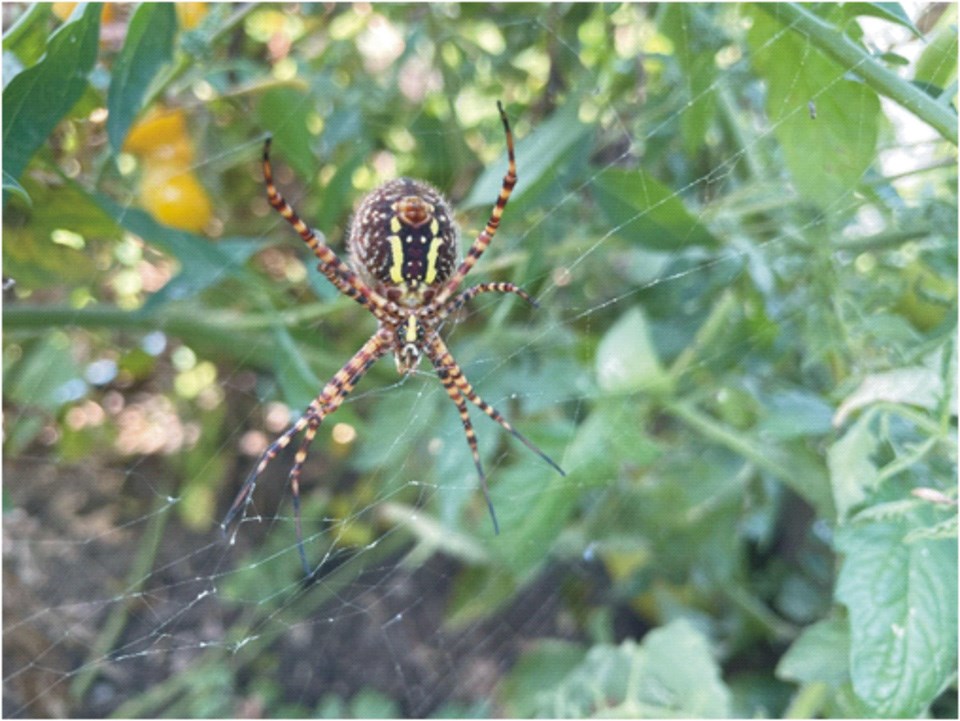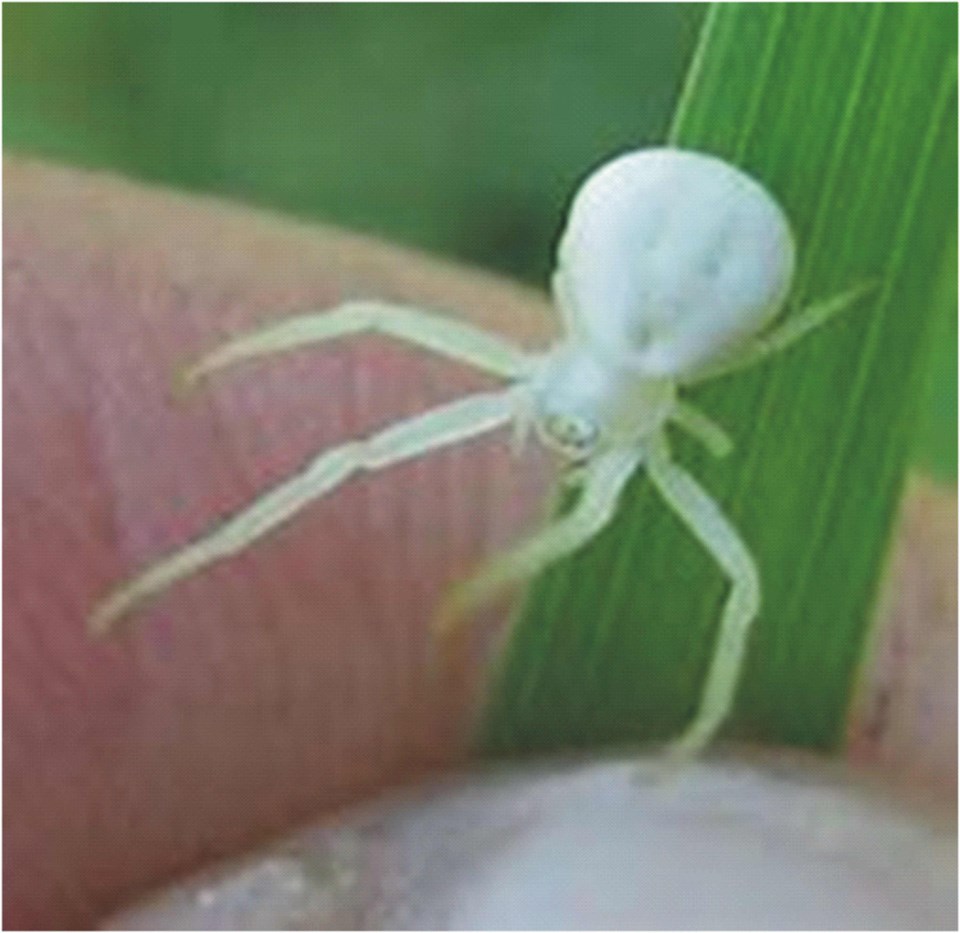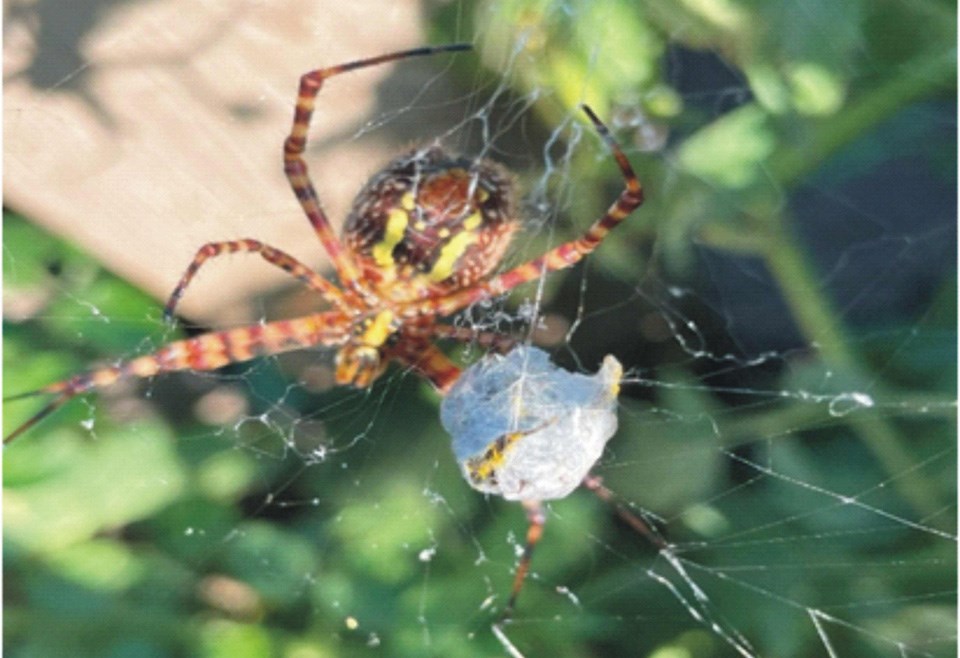I have always liked spiders, as anyone who read my 2024 Halloween article will have realized. For several summers, I have been observing a rather dramatic spider who lives in our allotment garden in Saskatoon. This spider lived in a web made in the potato plants in 2023 and in the tomato patch in 2024. The web was a very successful trap for any insects wandering around in the garden, judging by the size of the spiders at the end of the summer. The spiders became very obvious by September, quite a large, colourful spider with bright green/yellow patches on the body and obvious bands of colour on its long legs. I took photos over several months, both years, and the spider was identified as a Banded Garden spider (a very suitable name).

A banded garden spider in a tomato patch. | Photo by Jill Thomson

A crab spider. | Photo courtesy bugguide.net. CreativeCommons / Sara Simpkins
When I checked the internet for images of Argiope trifasciata, I realized I had only taken photos of the underside of the spider, with the obvious light greenish patches of colour and eight light and dark brown banded legs. Next summer, I will look for the light and dark stripes around the upper side of the spider, which makes it look rather different. The specimens I have seen in my garden are likely the females (13-14.5 millimetres) as the males are a lot smaller (about 1/3 of the size), which makes them less conspicuous. The male is seen in the web before mating, and then he usually dies. The female lays from 400 to over 1,000 eggs in an egg sac that is a light brown, papery structure, more pointed at the apex. When I saw one last year, I thought the spider had caught prey and wrapped it up in a “lunch sac”, but that was not true. The sac contained eggs that hatch in late summer/fall, but the spiderlings do not leave the sac until spring. Baby spiders are so cute. And I hope some survived how our garden plots were cleared of vegetation and cultivated in the spring. Some have survived the past two winters, as I have seen them in our patches of densely growing potatoes or tomatoes each summer. This year, I will be watching out for the females earlier in the season, and if I find egg sacs in the fall, I will take them home and find a safer, undisturbed place for them to overwinter.
These spiders are not aggressive and are very unlikely to bite gardeners unless threatened. Their venom is not harmful to humans, and a bite usually feels more like a pinch (according to a fact sheet I read, not from personal experience). These spiders are an asset to your garden as they trap and eat a wide range of insects, including mosquitoes, grasshoppers and wasps. However, they also eat beneficial insects such as bees and lacewings. Overpopulation by these spiders is prevented by predatory birds and larger spiders, and I usually only notice one in my garden, though this year (2025) I will be making more careful observations. I also want to look more closely at the web, which has a zig-zag pattern of strands in the centre (called a stabilimentum), which may help attract prey, or help prevent larger animals, like gardeners, from destroying the web. I am very pleased that these spiders live in our garden, as their presence is said to be “an indicator of environmental health and biodiversity in an ecosystem”.
Another type of spider that I have enjoyed observing for over 10 years is the small to medium-sized (usually about 10 millimetres long) flower crab spiders (Misumena vatia) that live in the rose bush beside our front drive. These spiders do not weave webs but are known as ambush predators as they lie in wait for their prey, and then catch and kill them. Our flowers are a bright pink, and the crab spiders are usually white with a rosy-pink band of colour. Crab spiders have two pairs of long front legs that curve inward, and they scuttle about like crabs. Typically, they lie in wait in the flower petals for an insect to land and start searching for pollen. They then move quickly and grab the insect with their long front legs. They bite the insect in the neck and pump venom into its body with hollow fangs. Like all spiders, crab spiders cannot eat solid food, so the venom is used to digest the contents of the prey, and the liquid food is then ingested. I noticed that both large and small bees visited our roses initially, and the spiders were only able to catch the small bees. I think either small bees are fast learners or the population was small initially, because it was not long before only the bigger bees were frequent visitors!
Watching the animals that share my garden spaces is a great source of pleasure for me, and I learn a lot when researching articles. There are so many interesting facts to be found and passed on.
Jill Thomson is a retired plant pathologist who enjoys gardening with her family, including the dogs, and learning more about Saskatchewan’s ecosystems.
This column is provided courtesy of the Saskatchewan Perennial Society (SPS; [email protected]). Check our website () or Facebook page () for a list of upcoming gardening events.




